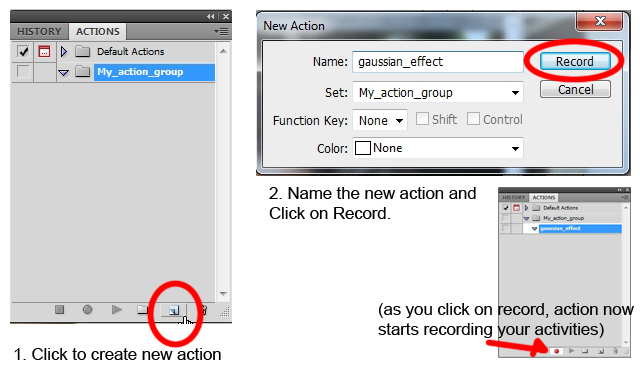Once you finish recording Actions (see how to record action in Photoshop?) in Photoshop, you may want to save it to avoid the risk of losing it on any kind of crash in your Photoshop. Thankfully, Adobe has made it easy for us to save and load our actions.
Video Walk-through
Saving Actions In Photoshop
Note: Photoshop does not allow us to save individual actions. We can only save Action Sets. So if you record or edit an action and want to save it, you'll need to select and save the entire action set. So I suggested that you should avoid placing your own actions inside default action sets that comes with Photoshop. Keep all of your actions inside your own action sets, which will make it easy to save them, load them, and keep them organized.
Here we go,To save an action set, first select the set you want to save in the Actions palette. We should have a couple of actions inside your Action Set. For now, I have "My_action_group" set - the "gaussian_effect" action that I created in the previous tutorial. I want to save this action set, so I'll select it in the Actions palette.
With the action set selected, click on the menu icon in the top right corner of the Actions palette, or if you're using Photoshop CS2 or earlier, click on the small right-pointing arrow. This brings up the Actions palette's menu. Click on Save Actions.
Photoshop will then pop up the Save dialog box. Save your action set to a location on your computer where you'll be able to easily access it later. I've created a folder on my Desktop named "my_actions" and I'll save the "My_actions_group" set into this folder. This will make it easy for me to find the action set later if I need to load it back into Photoshop. Make sure you save your action set with the extension ".atn" after the name if you want your actions to be playable on both a PC and a Mac. When you're ready, click on the Save button in the dialog box to save your actions.
Your actions are now saved. If Photoshop crashes at this point, your actions will be safe and you can load them into Photoshop the resides on any PC.
Resetting the Actions Palette to Defaults
Now as we've saved our actions, let's clear every actions leaving the Default Action Set. For this, click on the menu icon in the top right corner of the Actions palette, or the small arrow if you're using a version of Photoshop prior to CS3, and then click on Reset Actions from the menu.
Photoshop will pop up a warning box asking if you really want to replace the existing actions with the Default Actions set. Click OK to close the dialog box and reset your actions.
Loading Actions Into Photoshop
Now that we've cleared out our Actions palette, let's load the action set we saved a moment ago. Click on the menu icon top right corner of the Actions palette to bring up the menu, then select Load Actions from the menu choices.
This brings up the Load dialog box. Navigate to where you saved your action set on your computer, select the action set, then click on the Load button in the dialog box. My action set was saved to a folder named "my_ations" on my Desktop, so that's where I'll navigate to. I'll click on the "My_actions_group" set, then I'll click Load.
And now, if we look once again in the Actions palette, we can see that the "My_action_group" set has been successfully loaded back in to Photoshop.
You might have noticed that how the action set appears already twirled open in the Actions palette. That's because it was twirled open when I saved it. Action sets will appear either opened or closed after being loaded in to the Actions palette depending on how they appeared when they were saved.
We've now covered everything you need to know to get up and running with Photoshop actions! Cheers!!




































